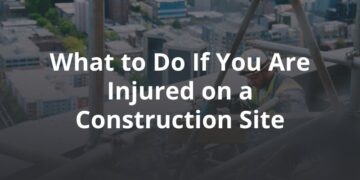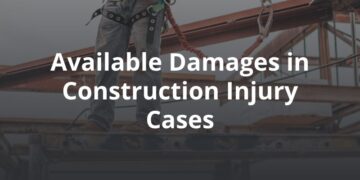Between heavy equipment, hazardous working conditions, industry practices, and human error, construction can be a dangerous industry. In fact, according to OSHA, construction professionals made up roughly one-fifth of all worker fatalities in 2018.
Even when construction accidents aren’t deadly, they can still cause life-changing injuries with long-term repercussions. And construction site accidents aren’t exactly uncommon. The Bureau of Labor Statistics reports that three out of every 100 construction workers sustained some sort of injury in 2018.
If you were injured on a construction jobsite, you may be entitled to compensation to cover your medical care, loss of income, and other expenses, losses, and damages. The following describes some of the most common types of injuries on construction sites.
Types of Construction Injuries
Below are some injuries we frequently see from those harmed in construction site accidents. If these harms and losses can be proven to have been caused by another party’s negligence, the injured party may be eligible for compensation. A construction site accident lawyer will take these factors — and their effect on your and your loved ones’ lives — into account as they help you determine whether or not you have a case for compensation and the potential value of your case.
- Sprains, strains, and tears. This is the most common type of work-related injury. While not as severe as other injuries, these kinds of medical problems can cause individuals to miss work and lose income. They may also cause complications in the future if not properly treated and healed.
- Cuts, lacerations, and punctures. Using tools, nails, and other sharp objects in the construction trade can result in these kinds of injuries, which can range from mild to severe. In the most serious cases, these wounds may require stitches, amputation, surgery, or other interventions and could cause complications like infection. In addition to medical care, lost income, and physical therapy, other possible harms and losses include household expenses, loss of earning capacity (if you are unable to return to work), and pain and suffering.
- Fractures and broken bones. Falls are one of the most frequent causes of accident in the construction industry and often cause fractures and breaks. Again, the treatment for these types of injuries and impact on your ability to work can vary greatly depending on how serious your injury is and how it affects your mobility and health. For instance, a minor fracture may heal within weeks, whereas a severe spinal fracture may cause loss of mobility, lifelong pain, or even paralysis.
- Eye injuries. The mishandling of hazardous chemicals and dangerous tools can result in harm to the eyes, which can compromise a victim’s sight or even cause permanent blindness. Eye injuries may be due to another party’s negligence, especially an employer if they fail to provide proper training or safety equipment. Compromised vision obviously has a huge impact on an individual’s ability to go about their daily lives and perform usual work duties, which usually translates to additional compensation in a construction accident case.
- Burns and electrocutions. Construction professionals who are involved with electrical work or who perform tasks involving flammable chemicals or equipment may sustain burns and electrocutions, which can be quite severe in some cases. Third- and fourth-degree burns typically require surgery, skin grafts, or other invasive treatments and may come with complications such as blood loss, infection, shock, tetanus, or even hypothermia. Needless to say, these kinds of injuries usually dictate intensive medical care and may greatly affect an individual’s livelihood and quality of life.
- Spinal cord injuries. Although less common than other injuries, spinal cord damage is typically very serious. Damage or compression to the nerves and vertebrae of the spine can cause extreme pain, loss of function, weakness, and numbness and tingling. If the spinal cord is seriously damaged or severed, an individual may suffer loss of mobility or even partial or total paralysis. Victims of spinal cord injuries usually require long-term care, extensive medical treatment, and physical therapy, which can negatively affect their financial health. Additionally, a seriously injured individual may never be able to return to work and may suffer pain, emotional distress, loss of quality of life, and other intangible losses.
- Traumatic brain injuries (TBI). TBIs occur when the brain is suddenly damaged, such as after being struck by a falling object — one of the most common types of injury on construction sites. TBIs usually seriously affect a person’s life. They may cause permanent brain damage, cognitive issues, mobility problems, functional impairment, personality changes, seizures, and other serious issues.
Sustaining an injury on the worksite is traumatic enough without having to worry about when and how you will return to work or afford medical expenses. Our construction site accident lawyers are sensitive to the distress these events leave in their wake. That’s why we offer a free case evaluation to individuals like you, who are looking for answers to their legal questions and advice on how to move forward with their case.
Contact us today and talk to an experienced legal professional who can educate you on your rights and options as you work to recover from your injury.







